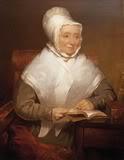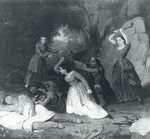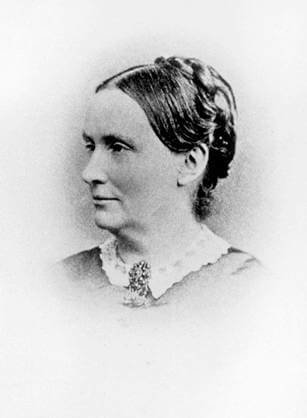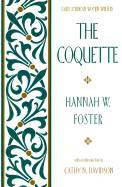First American Female Professional Writer
Hannah Adams was born on October 2, 1755, in Medfield, Massachusetts, the second of five children born to Thomas Adams and Elizabeth Clark Adams. Her grandfather Thomas Mason built the house in which Hannah was born, which is still standing. Her mother died when Hannah was 12 years old.
Image: Hannah Adams
Portrait by Chester Harding
As a child, Hannah was frail and timid. Afflicted by chronic ill health, to accompany her sister to school was a hardship. Finally allowed to stay at home, Hannah was taught by her father. She enjoyed the lessons because her father did not confine her to just the Bible, as was the custom in school at that time, but instead let her choose at will from books in his small library.
When Hannah was 16, the family’s finances were so depleted that her father began boarding some of the young men who were preparing for Harvard. Touched by Hannah’s eagerness for knowledge, these students taught her Greek, Latin, geography and logic. Strange studies for a girl, thought the local Medfield villagers but this girl was unique. She had a tremendous memory and such a far-away look that people said she was not of this world.
Though her father had inherited a comfortable fortune, he failed both as a farmer and a bookseller. His business failed when Hannah was 17 years old, and she began writing to support herself. Before long she was helping to support the family by tutoring the young men of Medfield who aspired to the college education she could not obtain.
Hannah developed a small circle of female friends, who were drawn together from Medfield and the surrounding towns by similarity of views. Most of them wrote verse, which was read and admired by those in the circle. Their mutual love of literature, lack of finances and indifference to the society of those whose minds were uncultivated, served to cement a union between them that remained throughout their lives. This group has been called the First Woman’s Club.
One of her father’s boarding students gave Hannah a copy of Thomas Broughton’s Historical Dictionary of all Religions From the Creation of the World to the Present Time, which greatly interested her. She was amazed and distressed at the lack of tolerance for some religions. She began to read everything she could find on the subject and from a side job knitting and sewing, she earned enough money to buy paper to make a blank notebook.
In 1778 she began to compile a new reference work according to her own rules. She resolved “to avoid giving the least preference of one denomination above another” and to present the arguments and sentiments of each sect in believers’ own words, according to the group’s “general collective sense.”
In 1784, hoping to provide some income for the family, Adams published her principal work, An Alphabetical Compendium of the Various Sects Which Have Appeared from the Beginning of the Christian Era to the Present Day. She was brave enough to allow her name to appear on the title page. The first edition sold out, but her agent took all the proceeds. The disappointment awakened Adams to the potential profits and the pitfalls of publishing.
When Hannah Adams entered the field of literature in 1784, only four American women had seen their writings in print: Anne Bradstreet, Phillis Wheatley, Mercy Otis Warren and Mary Rowlandson. And for them literature was just a hobby.
Adams kept a country school for several years and, meanwhile, sought another publisher and also lobbied for the United States’ first copyright law, passed in 1790. James Freeman, the newly installed minister of King’s Chapel in Boston, helped her to garner a long list of subscribers for a second, more profitable edition titled A View of Religions, published in 1791.
She dedicated it to her distant cousin John Adams, who was then Vice President of the United States. The volume sold well, and she earned more money than she had ever seen before and was able to pay off her debts, and continued to seek income from her historical research.
In 1799 Adams published A Summary History of New England, the first history to trace the United States from the Mayflower to the ratification of the U.S. Constitution. She became temporarily blind while writing this last book. In 1801, Adams published a shorter version as a schoolbook, An Abridgment of the History of New England.
A legal dispute followed with the Reverend Jedidiah Morse, who was publishing his own book on the subject. Plagiarism was possibly involved. Leading members of liberal religious families provided Adams with legal services and financial support. The battle dragged on for ten years and seems never to have been satisfactorily resolved, but contemporaries felt Morse was in the wrong. Although Adams disliked the controversy, it strengthened her ties with her supporters.
Despite troubles with her eyesight and sorrow, Adams lived a long, happy and productive life. Her later works included Truth and Excellence of the Christian Religion (1804), History of the Jews (1812), A Controversy with Dr. Morse – referring to their legal dispute (1814) and Letters on the Gospels (1826), which was written with the hope that she could make the New Testament interesting to the younger generation. A Dictionary of All Religions and Religious Denominations (1817) was the final edition of her first work.
In the process, Hannah Adams became the first American woman to reach a level where she could make her living entirely by writing. She was almost entirely self-taught, achieving financial independence and the respect of her male colleagues without the benefit of a formal education or family connections.
Several prominent men banded together to provide Adams with an annuity that eased the remaining years of her life. Her friends persuaded her to write her memoirs to leave a record of her literary struggles. Her autobiography was published in Boston the year after her death.
Hannah Adams died in Brookline, Massachusetts, on December 15, 1831, and was the first person buried in Mount Auburn Cemetery in Cambridge, Massachusetts.
Once among the most famous women in America, Hannah Adams’ name is somewhat obscure today. She was simple in her life, in her manners and extremely modest. A voyage from Boston to Nahant, about ten miles, was her only journey by water, and a trip to Providence, Rhode Island, her farthest by land. Yet she was a popular guest in New England society. She once stayed for two weeks at the home of her cousin John Adams while he was president, spending most of her time reading in his extensive library.
SOURCES
Hannah Adams
Wikipedia: Hannah Adams
About.com: Hannah Adams
Christian Writer Hannah Adams
Boston Athenaeum: Hannah Adams
Hannah Adams: Medfield’s Most Famous Female






